For many summers, beginning in the early 1990s, The Jim Cullum Jazz Band traveled to California to join the faculty of the Stanford Jazz Workshop on the Stanford University campus to lead a series of lectures and master classes, winding up with an annual concert in Dinkelspiel Auditorium on campus. This edition of Riverwalk Jazz captures Jim Cullum and his Band in a live recording of the radio show, “Bix and the Wolverines: Hot Jazz in the Midwest.”
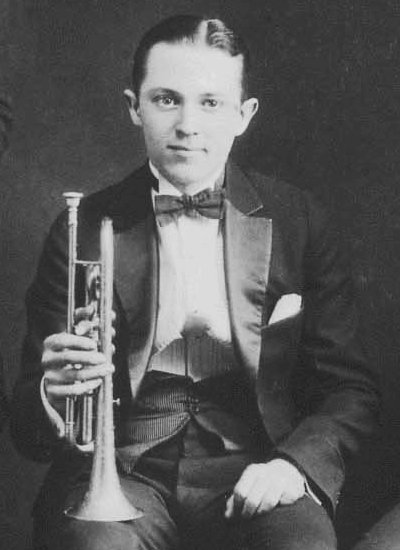
Portrait of a young Bix Beiderbecke. Photo in public domain.
The music of Bix Beiderbecke is a lifelong passion of bandleader Jim Cullum. He shares his insights with the radio audience: “In 1922 Bix was 19 years old and causing his parents a lot of grief over his love affair with jazz. By the following summer his parents Bismarck and Agatha Beiderbecke felt they had lost their son. Bix’s frustrated parents saw a life of tragedy ahead for him, and in many ways they were right. They sensed danger, but it was already too late. Bix had tasted the thrill of improvising magnificent music— on the spot. This magical experience spoke to him and said, ‘Come on, this is life!’ He would chase this sweetness to the end.”
Guitarist Eddie Condon was one of the many jazz musicians who played with Bix and he was one of Bedierbecke’s true disciples. In his autobiography We Called it Music, Condon wrote about hearing Bix play for the first time: “Beiderbecke pulled out a silver cornet. He put it to his lips and blew a phrase. The sound came out like a girl saying ‘yes.’” Others described that sound as a “padded mallet striking a chime” or like “pearls falling onto velvet.” Jim Cullum says, “Here’s the way I hear it: it’s a fat sound, broader and less strident, darker and more mellow than other cornet players. But it’s not just dark and mellow, it has a hollow ring that sometimes reminds me of a bell, and when Bix bears down, sometimes he gets a brass edge on the top of all that sound. For me, it’s the most beautiful musical sound I’ve ever heard. Like many other Bix-influenced players, I don’t want to simply copy Bix, but I do listen to the master playing in my head, and sometimes I work to see just how fat the sound can get.”
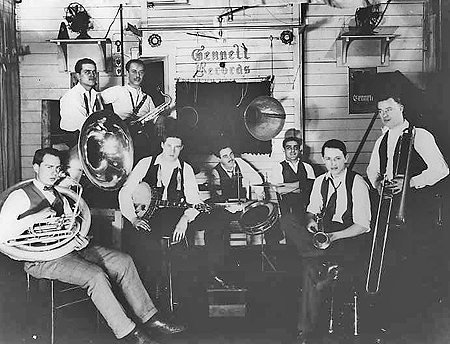
The Wolverine Orchestra at Gennett Recording Studio, 1924. Photo courtesy of the Duncan Scheidt Collection.
Bix Beiderbecke created some of his most exciting work with the Wolverine Orchestra in a single year—between 1923 and 1924. The band took their name from a tune they loved to play, Jelly Roll Morton’s “Wolverine Blues.” The Wolverines evolved out of a group of musicians Bix played with in clubs in the Midwest and on excursion boats on Lake Michigan. Bix and the Wolverines stand out in jazz history for their pure, hot jazz. They never compromised their musical vision by simply playing “covers” of the pop music of the day.
In early 1924 the Wolverine Orchestra had a couple of important breaks. They made their first recording at the Gennett studio in Richmond, Indiana, and they played their first performance on a college campus where they found an audience that understood what they were trying to do with their music. The college crowd at a Junior Prom in Indianapolis went wild over the Wolverines. Playing as many as ten out choruses on several tunes that night, the band whipped themselves and the dancers into a frenzy. Bix and the rest of the horn players gathered around the rhythm section at the back of the stage, blowing right at the drummer, egging him on. The raw power of the Wolverines’ music had an instant appeal for these newly liberated college kids in short skirts and baggy flannels at the dawn of the Jazz Age.
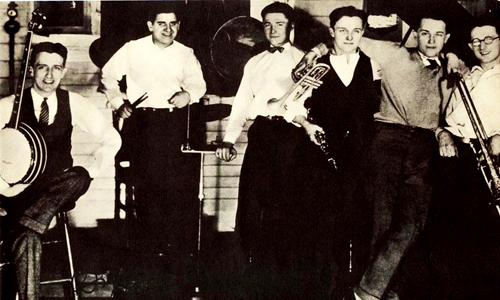
Bix and His Rhythm Jugglers at Gennett studio, 1925. Photo courtesy of Big Band Database.
The Wolverines made their first recordings at the Gennett Studio in February 1924. Jim Cullum notes, “The guys in the band were astounded when they heard a playback of their first test pressing. From the wild response their performances provoked on college campuses, the players had an inkling something special was happening with their music. Hearing that first recording, they knew it was special, and the band’s confidence soared.” Bix and the Wolverines ended the summer of 1924 in Indiana at Miller Beach, playing their hot jazz for kids dancing the Toddle, the Eagle Rock and the Mooch.
By August 1924, the Wolverines were on a roll. Suddenly, other bands in the Midwest copied their style. Like others, the Wolverines dreamed of making it big in New York. In September, three carloads of scruffy, young musicians chugged off to the Big Apple. Several unexpected detours later, an exhausted and irritable pack of Wolverines rolled into Manhattan for a gig at the Cinderella Ballroom at 48th St. and Broadway. The raw power of Bix and the Wolverines was a huge success in New York. Lured away by the top bandleader of the day, Bix wound up a star attraction with the Paul Whiteman Orchestra. The sweet life of playing pure hot jazz with the Wolverines was over for Bix.
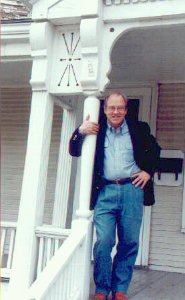
Jim Cullum visiting the Beiderbecke House in Davenport, Iowa.
As the years began to slide by, Bismarck and Agatha Beiderbecke continued to hope that Bix would somehow grow up and enter a life of what they considered ‘real’ work and success. Words of praise for Bix’s accomplishments seem to have been withheld. His parents could not share their son’s passion. Bix continued to chase his addictions. From his obsession with jazz improvisation, he turned to alcohol. Jim Cullum says, “Of course, Bix was a bit of a misfit at home among the green pastures of Iowa, but I think he would have experienced a similar pattern regardless of his parents’ resistance or encouragement. He seemed to have a streak of melancholy in his music and his life. This bittersweet quality may be the most compelling element in his music, for while the Beiderbecke sound is filled with joy—it is hot and swinging—it often carries a subtle sadness.”
More about the music performed here by The Jim Cullum Jazz Band:
Hoagy Carmichael’s original title for “Riverboat Shuffle“ was “Free Wheeling.” It was Hoagy’s first tune, and was composed for a 1924 session by Bix and the Wolverines while Hoagy was a student at Indiana University in Bloomington. Bix would record “Riverboat Shuffle” again in 1927 with saxophonist Frank Trumbauer. Hoagy Carmichael said he always had the sound of Bix’s cornet in his head, especially while composing his first great success, “Star Dust.”
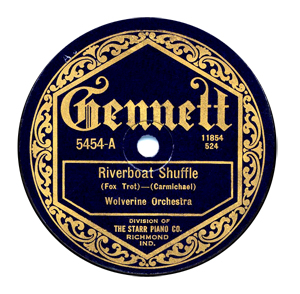
Riverboat Shuffle record label courtesy of the Starr-Gennett Foundation.
“I Need Some Pettin,'“ “Oh Baby (Don't Say No, Say Maybe) and “Susie (of the Islands)“ were recorded in 1924 by Bix and the Wolverines at the ragtag Gennett studio in Indiana. Also recorded in 1924 for Gennett, Bix made “Big Boy“ at the label’s New York studio.
Performed here by The Jim Cullum Jazz Band, two titles originate from a 1927 session with Frank Trumbauer and His Orchestra: “Singin' the Blues (Till My Daddy Comes Home) “ and the melancholy “Blue River.“
Working with the Paul Whiteman Orchestra in 1928, Bix Beiderbecke recorded “San“ and “There Ain't No Sweet Man Worth the Salt of my Tears“ in New York City.
Photo credit for Home Page: Bix and the Wolverines. Photo from the book “Bix: The Definitive Biography of a Jazz Legend“ by Jean Pierre Lion and Gabriella Page-Fort
Text based on Riverwalk Jazz script by Margaret Moos Pick ©1998

